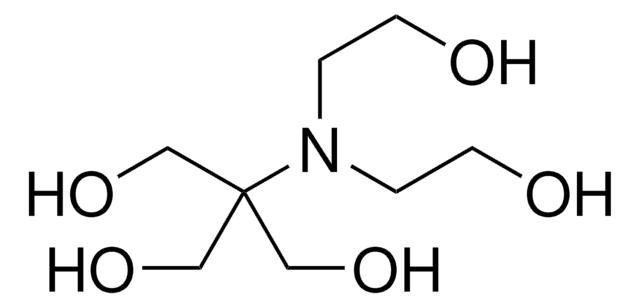B9754
BIS-TRIS
≥98.0% (titration)
Synonym(s):
2,2-Bis(hydroxymethyl)-2,2′,2″-nitrilotriethanol, 2-Bis(2-hydroxyethyl)amino-2-(hydroxymethyl)-1,3-propanediol, Bis(2-hydroxyethyl)amino-tris(hydroxymethyl)methane
About This Item
Recommended Products
Quality Level
assay
≥98.0% (titration)
form
crystalline powder
storage condition
dry at room temperature
technique(s)
UV/Vis spectroscopy: suitable
electrophoresis: suitable
color
white
useful pH range
5.8-7.2
pKa (25 °C)
6.5
solubility
H2O: 500 mg/mL, clear, colorless to very faintly yellow
suitability
suitable for Western blot
suitable for column chromatography of proteins
application(s)
diagnostic assay manufacturing
general analytical
microbiology
SMILES string
OCCN(CCO)C(CO)(CO)CO
InChI
1S/C8H19NO5/c10-3-1-9(2-4-11)8(5-12,6-13)7-14/h10-14H,1-7H2
InChI key
OWMVSZAMULFTJU-UHFFFAOYSA-N
Looking for similar products? Visit Product Comparison Guide
Related Categories
General description
Application
- as a buffer for Electrophoresis
- as a component of transfer buffer for Western Blotting
Features and Benefits
- Suitable for Biological and Biochemical Research
- Effective Buffering from pH 5.8-7.2 (25 °C) with a pKa of 6.5 (25 °C)
Other Notes
signalword
Warning
hcodes
Hazard Classifications
Eye Irrit. 2
Storage Class
11 - Combustible Solids
wgk_germany
WGK 1
flash_point_f
Not applicable
flash_point_c
Not applicable
ppe
dust mask type N95 (US), Eyeshields, Gloves
Certificates of Analysis (COA)
Search for Certificates of Analysis (COA) by entering the products Lot/Batch Number. Lot and Batch Numbers can be found on a product’s label following the words ‘Lot’ or ‘Batch’.
Already Own This Product?
Find documentation for the products that you have recently purchased in the Document Library.
Customers Also Viewed
Our team of scientists has experience in all areas of research including Life Science, Material Science, Chemical Synthesis, Chromatography, Analytical and many others.
Contact Technical Service












